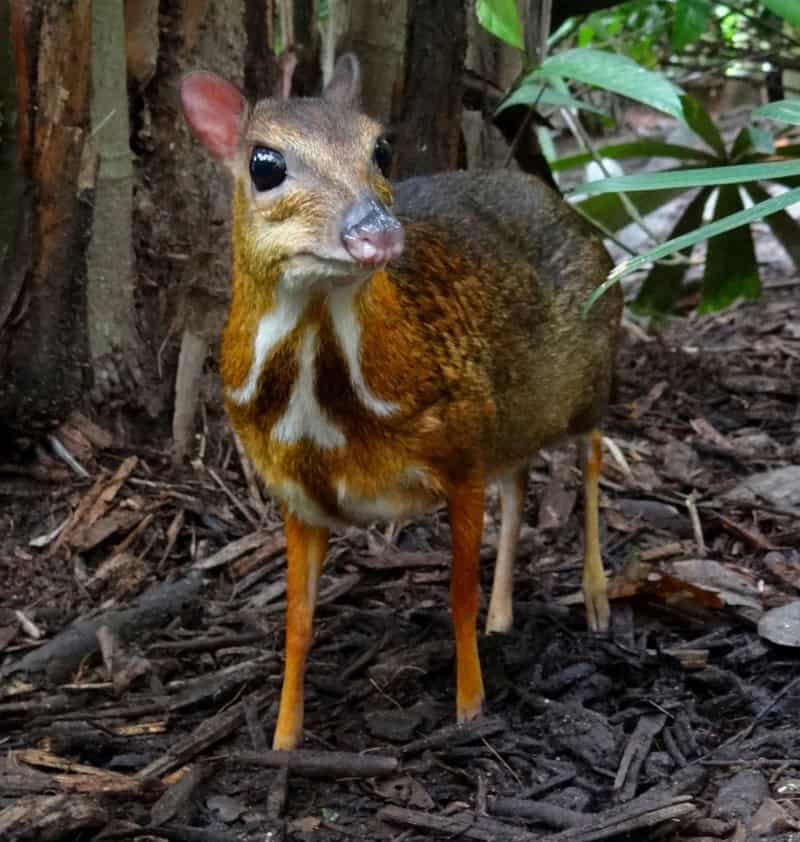
Greater Malay Chevrotain Facts
- The remarkable Greater Malay Chevrotain represents a small species of ungulate. Sadly, it also remains in danger of extinction. This fact partially occurs due to the fact that the local inhabitants of its endemic region continue to routinely hunt the animal as a food source.
- The effects of continued, and escalating, deforestation of the area it inhabits has reduced habitable land for the creature. The mammal also faces the threat of climate change. However, the IUCN does not list the animal on its Red List of Threatened Species.
- Many researchers believe that this lovely animal would likely be extinct already, were it not for one unusual aspect of its particular physiology. That pertains to the extremely rapid reproductive processes this fascinating animal evolved.
- The Greater Malay Chevrotain achieves sexual maturity at only 4.5 months of age. The fabulous creature also possesses a lifespan of roughly 14 years. The two factors provide it with a significant evolutionary advantage that it employs to its benefit.
Related Articles
African Bish Pig Reindeer Saiga Antelope
CC License: https://bit.ly/2X5m1EW
Greater Malay Chevrotain Physical Description
Despite its relatively tiny size, the Greater Malay Chevrotain holds some surprises in store for those who research it. That’s especially true of those new to knowledge of it. In fact, it actually constitutes one of the largest members of its genus.
Further, the unique creature possesses a quite tiny average head-and-body length. This measures a total of only about 2.5 ft (75 cm). To this, the relatively short tail of the remarkable mammal adds another 4 in (10 cm) to the overall length.
Furthermore, mature adults of the animal also remain small in other statistics. These attain an average height measuring roughly 14 in (35 cm) at the shoulder. Additionally, the weight of this magnificent species rarely exceeds 18 lb (8 kg).
The head develops as small and triangular in shape, giving it a distinctive appearance. Meanwhile, the legs develop extremely thin, even in relation to the rest of the body. Also, the hind legs of the animal also remain noticeably longer than the front legs.
In color, this creature appears a mixture of gray, brown, and orange on the upper body. The neck, stomach, chin, and chest typically display white. Finally, the males of the Greater Malay Chevrotain also possess a set of elongated canine teeth projecting from the upper jaw.
- Kingdom: Animalia
- Phylum: Chordata
- Class: Mammalia
- Order: Artiodactyla
- Family: Tragulidae
- Genus: Tragulus
- Species: T. napu
Greater Malay Chevrotain Distribution, Habitat, and Ecology
The Greater Malay Chevrotain only exists in widely scattered portions of Asia. These mainly consist of the countries of Borneo, Sumatra, southern Myanmar and Thailand. Yet it also appears in the Malay Peninsula, and also several small islands in the region.
The remarkable animal also has decided preferences for where it lives. It prefers to inhabit either mangrove thickets or regions of tropical rainforest. Yet, it is most commonly found residing near bodies of water. It also evolved as a primarily terrestrial species.
The fascinating mammal lives as a primarily nocturnal creature. It also typically lives a solitary life. To the best of the knowledge of researchers, the lone exception to this appears to be for mating purposes. Further, the males are notoriously territorial.
The unusual ungulate also remains entirely herbivorous in its dietary habits. Individuals primarily feed on a wide variety of small, locally indigenous plants. These include shrubs, grass, buds, leaves, fallen fruits, and aquatic plants.
The magnificent Greater Malay Chevrotain depends heavily upon its reproductive capacities for its survival as a species. In point of fact, the animal breeds throughout the year, and the female spends most of her adult life pregnant.
But this marvel of Nature isn’t done quite yet. That holds true due to the fact that it possesses one more factor of its nature to impress us. That’s because, incredibly, infants become fully active within 30 minutes following their birth.
Species Sharing Its Range
White Egret Orchid Orchid Mantis Binturong
Check out our other articles on Laotian Giant Flying Squirrel, North American Beaver, Opossum, 5 Marvels of New Zealand and Australia, Chatham Island forget-me-not
